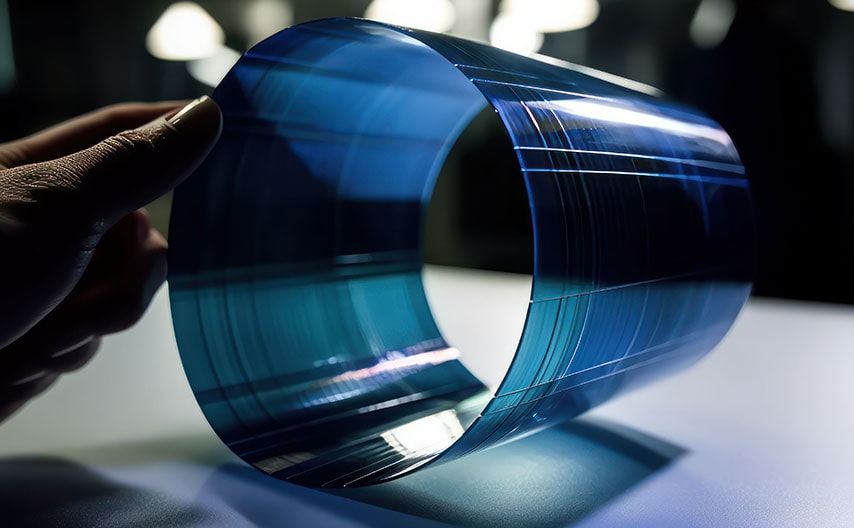thin-film solar cells
Photovoltaic systems, more commonly known as solar cells, can be made not only from silicon, but also from other materials. Among the so-called thin-film solar cells, those made from perovskites are particularly promising. In just under two decades, it has been possible to increase the efficiency of perovskite solar cells to that of the best silicon-based cells (Si cells). In comparison, perovskite-based cells have a number of advantages (but also disadvantages).
What are perovskites?
The term perovskite (named after a Russian mineralogist) originally stood for calcium titanium oxide (Ca2TiO3), also known as calcium titanate. The term was later extended to materials that have a comparable special crystal structure (orthorhombic to cubic). Today, perovskite (Pk) refers to materials with the structure ABX3, where A, B and X can represent different elements and compounds. In addition to the Pk layer, a perovskite-based solar cell contains many other components - the best structure for optimum stability and maximum efficiency is being researched by many research institutes and companies worldwide.

The advantages of perovskite solar cells

Pk cells offer several advantages that make them an attractive alternative to Si cells. From 2009 to 2024, the efficiency of Pk cells achieved in the laboratory rose from 3.8 per cent to 26.1 per cent - almost as high as the highest value ever achieved by Si cells (26.8 per cent). However, while Si cells primarily convert red and infrared light, perovskites can also utilise shorter wave light. The most promising approach therefore seems to be to combine Pk and Si layers in order to utilise the full light spectrum for energy generation - more on these so-called tandem solar cells later.
Perovskites consume significantly less energy during production than silicon, which requires temperatures of over 1000°C - and due to the thin layers, much less material (by a factor of 100!) is consumed. The installation of Pk cells is more flexible thanks to additional options such as colour design and transparency. This makes Pk cells attractive for many surfaces that cannot be reached with Si cells, for example house walls, roofs with low load-bearing capacity and much more.
What are the challenges?
So far, almost all efficiency records and design achievements have been reached with perovskite cells in the laboratory and on small surfaces - scaling and industrialisation are still largely pending. The main problem in practice is the durability of the Pk cells: They are more sensitive to moisture and environmental influences than Si cells (service life is approx. 25-30 years), so their service life is currently estimated at months to a few years. Intensive research is currently underway to increase the service life.
There are several approaches, such as limiting ion mobility, reducing chemical reactions (through encapsulation) and using more robust boundary layers. In an article published in Nature at the beginning of the year, Chinese researchers describe how they have succeeded in creating stable Pk cells that also perform very well in long-term stress tests using a controlled ion movement limited to the perovskite layer.
What are tandem solar cells?
Currently, tandem solar cells made from silicon and perovskite layers probably have the greatest potential. If these two materials are combined, larger areas of the light spectrum can be utilised and even efficiencies beyond 33.2 per cent, the physical limit for a single material, are possible. The current record is 33.9 per cent - well above the value achievable with pure Si cells. In principle, tandem and multi-cells made of perovskite layers only are possible as well (and exhibit similar efficiencies); however, this exacerbates the stability problem.

What are the latest developments?
Oxford PV was the world's first commercial manufacturer to deliver the first perovskite silicon tandem modules to a customer in the USA in September 2024. The 72-cell modules produced near Berlin achieve a high efficiency of 24.5 per cent; as yet, nothing is known about the expected service life. The extent to which this marks the beginning of a new era in solar energy generation remains to be seen - what is certain, however, is that the potential of perovskite technology is enormous in terms of amortisation time.
What does INGUN's offer for photovoltaic applications?
Both the efficiency optimisation of solar cells and production as a whole depend on suitable testing technology that enables contacting with as little shading as possible. Test probes from INGUN are specially designed to minimise shading. In addition, the four-wire technology can be used to compensate for line (finger) influences and measure current and voltage on the device under test simultaneously. In collaboration with customers, partners and research institutes, INGUN is constantly developing new solutions that are essential for bringing innovative technologies to market - such as test strips for contacting busbarless solar cells.
